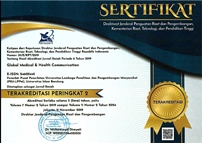Effect of Umbilical Cord-derived Mesenchymal Stem Cell Secretome on Corpus Cavernosum Elastography Results in Patients with Severe Erectile Dysfunction Non-responsive to Sildenafil
Abstract
Erectile dysfunction is one of the most common male sexual dysfunctions, defined as the inability to get or maintain an erection, and its prevalence is increasing over time. The current treatment, using a phosphodiesterase-5 inhibitor like sildenafil, only offers a temporary solution. Secretome, a bioactive substance derived from mesenchymal stem cells from the umbilical cord, has shown remarkable regenerative capabilities. This study aims to explore the potential of administering umbilical cord-derived mesenchymal stem cell secretome to patients with severe erectile dysfunction and evaluate its impact on the stiffness of the corpus cavernosum using elastography in the flaccid phase. This study employed a pre-experimental design with a pre-post test. It involved seven patients who came to Dr. Soetomo Hospital with severe erectile dysfunction that was unresponsive to sildenafil. Elastography evaluation, including strain and shear wave elastography, was performed before and one month after secretome injection, which was carried out from March to April 2024. Data were analyzed using the paired sample t-test when the data distribution was normal and the Wilcoxon test when the data distribution was not normal. There were statistically significant changes (p<0.05) in all patients who underwent strain and shear wave elastography of the corpus cavernosum before and one month after secretome administration, indicating an improvement in stiffness. In conclusion, intracavernosal administration of umbilical cord-derived mesenchymal stem cell secretome has demonstrated promising results in treating severe erectile dysfunction non-responsive to sildenafil therapy. These results include improved penile tissue in the corpus cavernosum, as evidenced by decreased stiffness on elastography.
Keywords
Full Text:
PDFReferences
Shamloul R, Ghanem H. Erectile dysfunction. Lancet. 2013;381(9861):153–65.
Wang CM, Wu BR, Xiang P, Xiao J, Hu XC. Management of male erectile dysfunction: from the past to the future. Front Endocrinol (Lausanne). 2023;14:1148834.
Varela CG, Yeguas LAM, Rodríguez IC, Vila MDD. Penile doppler ultrasound for erectile dysfunction: technique and interpretation. Am J Roentgenol. 2020;214(5):1112–21.
Utomo E, Blok BF, Pastoor H, Bangma CH, Korfage IJ. The measurement properties of the five-item International Index of Erectile Function (IIEF-5): a Dutch validation study. Andrology. 2015;3(6):1154–9.
Gonzalez-Cadavid NF. Mechanisms of penile fibrosis. J Sex Med. 2009;6(Suppl 3):353–62.
Illiano E, Trama F, Ruffo A, Romeo G, Riccardo F, Iacono F, et al. Shear wave elastography as a new, non-invasive diagnostic modality for the diagnosis of penile elasticity: a prospective multicenter study. Ther Adv Urol. 2021;13:17562872211007978.
Mollaioli D, Ciocca G, Limoncin E, Di Sante S, Gravina GL, Carosa E, et al. Lifestyles and sexuality in men and women: the gender perspective in sexual medicine. Reprod Biol Endocrinol. 2020;18(1):10.
He M, von Schwarz ER. Stem-cell therapy for erectile dysfunction: a review of clinical outcomes. Int J Impot Res. 2021;33(3):271–77.
Daneshmandi L, Shah S, Jafari T, Bhattacharjee M, Momah D, Saveh-Shemshaki N, et al. Emergence of the stem cell secretome in regenerative engineering. Trends Biotechnol. 2020;38(12):1373–84.
Margiana R, Abdullah MF, Pakpahan C, I’tishom R, Supardi S, Saoemi HA, et al. Analyzing the current umbilical cord-derived mesenchymal stem cell secretome evidence for erectile dysfunction management. Biomol Health Sci J. 2023;6(2):141–6.
Mukti AI, Ilyas S, Warli SM, Putra A, Rasyid N, Munir D, et al. Umbilical cord-derived mesenchymal stem cells improve TGF-β, α-SMA and collagen on erectile dysfunction in streptozotocin-induced diabetic rats. Med Arch. 2022;76(1):4–11.
Al Demour S, Adwan S, Jafar H, Rahmeh R, Alhawari H, Awidi A. Safety and efficacy of 2 intracavernous injections of allogeneic Wharton’s jelly-derived mesenchymal stem cells in diabetic patients with erectile dysfunction: phase 1/2 clinical trial. Urol Int. 2021;105(11–12):935–43.
Mangir N, Akbal C, Tarcan T, Simsek F, Turkeri L. Mesenchymal stem cell therapy in treatment of erectile dysfunction: autologous or allogeneic cell sources? Int J Urol. 2014;21(12):1280–5.
Altinbas NK, Hamidi N. Penile doppler ultrasonography and elastography evaluation in patients with erectile dysfunction. Pol J Radiol. 2018;83:e491–9.
Zheng X, Ji P, Mao H, Wu J. Evaluation of penile erection rigidity in healthy men using virtual touch tissue quantification. Radiol Oncol. 2012;46(2):114–8.
Inci E, Turkay R, Nalbant MO, Yenice MG, Tugcu V. The value of shear wave elastography in the quantification of corpus cavernosum penis rigidity and its alteration with age. Eur J Radiol. 2017;89:106–10.
Zhang JJ, Qiao XH, Gao F, Bai M, Li F, Du LF, et al. Smooth muscle cells of penis in the rat: noninvasive quantification with shear wave elastography. Biomed Res Int. 2015;2015:595742.
Turkay R, Inci E, Yenice MG, Tugcu V. Shear wave elastography: can it be a new radiologic approach for the diagnosis of erectile dysfunction? Ultrasound. 2017;25(3):150–5.
Rong X, Li J, Yang Y, Shi L, Jiang T. Human fetal skin-derived stem cell secretome enhances radiation-induced skin injury therapeutic effects by promoting angiogenesis. Stem Cell Res Ther. 2019;10(1):383.
Saheli M, Bayat M, Ganji R, Hendudari F, Kheirjou R, Pakzad M, et al. Human mesenchymal stem cells-conditioned medium improves diabetic wound healing mainly through modulating fibroblast behaviors. Arch Dermatol Res. 2020;312(5):325–36.
DOI: https://doi.org/10.29313/gmhc.v13i1.14144
pISSN 2301-9123 | eISSN 2460-5441
Visitor since 19 October 2016:
Global Medical and Health Communication is licensed under a Creative Commons Attribution-NonCommercial-ShareAlike 4.0 International License.






























.png)
_(1).png)
_(1).jpg)
